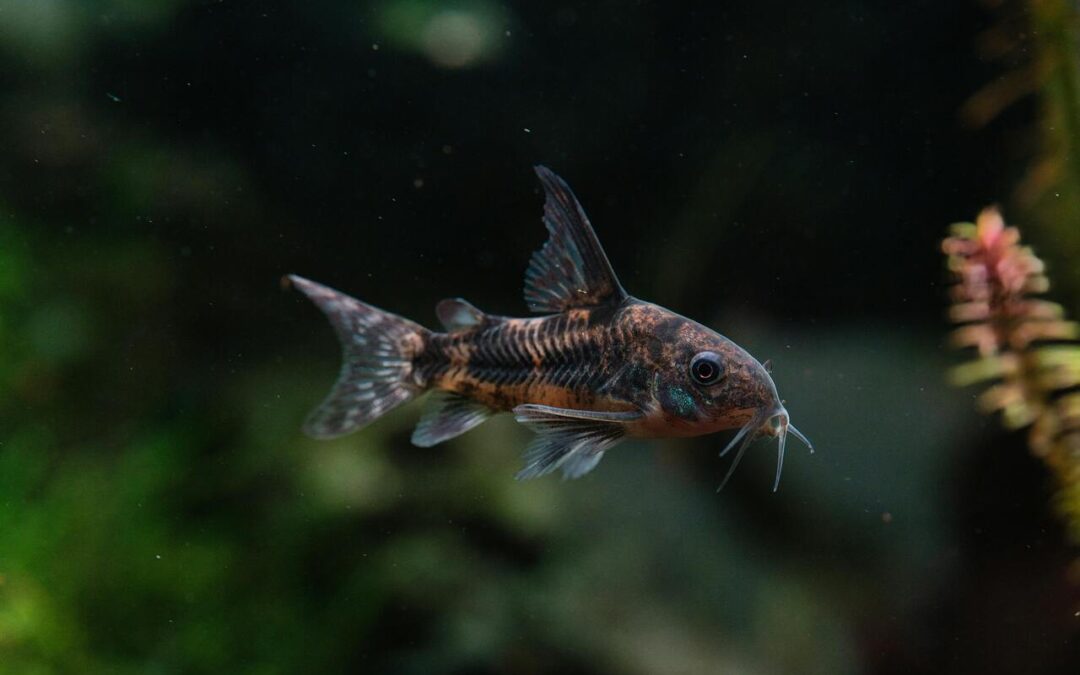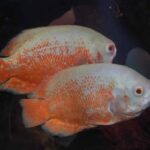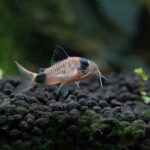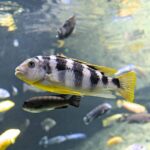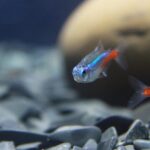If you’ve ever kept Corydoras catfish in your aquarium, you know how delightful and active these little bottom-dwellers can be. But sooner or later, if conditions are right, you may notice tiny, sticky eggs scattered across the glass, plants, or even decorations. These are Corydoras eggs, and caring for them properly is key if you want to raise healthy fry.
This guide covers everything you need to know about Corydoras eggs: how to identify them, the difference between fertilized and unfertilized eggs, how to prevent fungus, incubation tips, and how to care for the fry once they hatch.
Identifying Corydoras Eggs
Corydoras eggs are relatively easy to spot once you know what to look for:
- Appearance: They’re small, round, and sticky. Corydoras usually attach them to hard surfaces like aquarium glass, plant leaves, or decorations.
- Color: Fertilized eggs tend to be clear with an orange or yellow tint, showing signs of growth inside.
- Unfertilized Eggs: These turn cloudy or milky white. They don’t develop and often become prone to fungal growth.
Why Do They Lay Eggs on Hard Surfaces?
Corydoras prefer smooth, stable areas because the sticky texture of their eggs allows them to cling securely. Glass walls, broad-leafed plants, or even plastic decorations often become their chosen nursery.

Fertilized vs. Unfertilized Eggs
One of the first things aquarists want to know is whether the eggs they’ve spotted will hatch.
- Fertilized eggs: Slightly transparent with a visible yellowish or orange center. Over time, you may even notice tiny developing fry inside if you look closely.
- Unfertilized eggs: Opaque, turning milky white. These are not viable and can quickly grow fungus.
The Fungus Problem
Fungal growth is one of the biggest threats to Corydoras eggs. It spreads quickly and can harm healthy eggs nearby. That’s why aquarists often remove unfertilized eggs right away.
Collecting and Incubating Corydoras Eggs
If you want the best chance at raising fry, you’ll need to collect and incubate the eggs separately.
Gentle Removal
Use a clean scraper, a razor blade, or even your fingers to gently lift the eggs from glass or plants. Be gentle—pressure can crush them. Place the eggs in a separate hatching container or breeder box.
Fungicide Treatment
To prevent fungal growth, many aquarists treat the eggs with methylene blue, a common antifungal. Follow the product’s instructions carefully, as overdosing can harm the developing fry. Some breeders also use Indian almond leaves, which release tannins with mild antifungal properties.
Incubation Setup
- Container: A small breeder box, a plastic container inside the main tank, or a separate tank works fine.
- Water Flow: Use a sponge filter or an air stone to provide gentle water movement. This prevents stagnation without disturbing the eggs.
- Temperature: Keep the water stable, ideally around 75–78°F (24–26°C) for faster, healthy development.
Hatching Timeline
Corydoras eggs usually hatch in about 72 hours (3 days), though the exact time may vary depending on species and water temperature.
You’ll know hatching is close when the eggs darken, and you may even spot tiny fry wriggling inside.
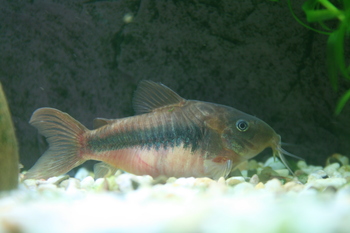
Caring for Corydoras Fry
Once the fry hatch, they’re fragile and need special care to survive.
First Days After Hatching
The fry will absorb their yolk sacs for the first day or two, so they don’t need immediate feeding. After that, they’ll need a steady supply of tiny foods.
Feeding Fry
- Start with infusoria or liquid fry food for the smallest species.
- Move on to baby brine shrimp or microworms once they’re large enough.
- As they grow, introduce finely crushed flake food or specialized fry pellets.
Water Maintenance
Clean water is absolutely crucial. Perform small, daily water changes to prevent waste buildup. A sponge filter is recommended, as it provides gentle filtration without sucking up the fry.
Growth Stages
- First 2 weeks: The fry are extremely delicate and prone to water quality issues.
- 1 month+: They start to resemble miniature Corydoras and can be gradually transitioned into the main tank once they’re big enough not to be eaten by other fish.
Tips for Success
- Conditioning adults: If you want more spawns, feed adult Corydoras high-quality foods like bloodworms, daphnia, and sinking pellets.
- Mimic rainy season: Cooler water changes often trigger spawning, as it simulates rainfall in their natural environment.
- Remove adults: Corydoras don’t usually eat their eggs, but they may eat newly hatched fry, so it’s safer to separate them.
Common Problems with Corydoras Eggs
- Egg Fungus – Treat with methylene blue or remove infected eggs.
- Low Hatch Rates – Often due to poor water quality or infertile males.
- Fry Mortality – Can be linked to dirty water, lack of proper food, or being placed in too strong a current.
Fascinating Facts About Corydoras Eggs and Breeding
Learning the technical side of Corydoras egg care is important, but sometimes the little quirks and fun facts make the experience even more rewarding. Corydoras aren’t just egg-layers—they’re unique in how they spawn, how they care for their eggs (or don’t), and even how their behavior in the aquarium mirrors what they do in the wild. Let’s take a closer look.
1. The “T-Position” Spawning Dance
If you’ve ever seen Corydoras spawn, you might have noticed a strange, almost choreographed behavior known as the T-position. The male swims up to the female and presses against her head and barbels, forming a “T” shape. At this point, the female holds a few eggs between her pelvic fins while the male fertilizes them. Afterward, she swims off and carefully deposits the sticky eggs on glass, plants, or decorations.
This ritual repeats several times until she’s laid dozens—or even hundreds—of eggs. For aquarists, watching this natural behavior is one of the most fascinating parts of keeping Corydoras.
2. Egg Stickiness Is a Survival Trick
Corydoras eggs are sticky for a reason: in the wild, they need to cling to rocks, plant stems, or submerged wood in fast-moving waters. If the eggs weren’t adhesive, they’d get washed away, leaving them vulnerable to predators and unable to hatch. In the aquarium, this means you’ll often find them plastered to glass walls, filter intakes, or even the underside of plant leaves.
3. They Don’t Guard Their Eggs
Unlike some fish species—such as bettas or angelfish—Corydoras don’t stick around to guard their eggs. Once the female lays them, her job is done. This is part of the reason aquarists step in to collect and incubate the eggs: without intervention, fungus or hungry tankmates could wipe out an entire spawn.
4. Egg Numbers Depend on the Species
Not all Corydoras lay the same number of eggs. Smaller species like Corydoras pygmaeus or Corydoras hastatus tend to produce fewer eggs in one spawn—sometimes only 20–40. Larger species, such as Corydoras aeneus (the bronze cory), can produce 100 or more eggs at a time. For serious breeders, knowing your species’ tendencies helps you prepare the right setup for hatching and raising fry.
5. Water Changes Often Trigger Spawning
In the wild, Corydoras are accustomed to seasonal changes, particularly the rainy season. Fresh, cooler water signals that it’s time to breed. Aquarists mimic this by performing a large water change with slightly cooler water, often sparking spawning behavior within hours. It’s almost like magic—the fish respond to these environmental cues as if they’re still in their natural river habitats.
6. Fry Are Bottom-Dwellers from the Start
Unlike many baby fish that hover near the surface, Corydoras fry instinctively stay near the bottom of the tank, just like their parents. This means you’ll need to provide sinking foods and make sure food particles reach the substrate where the fry can easily find them.
7. Breeding Corydoras Can Help Preserve Wild Populations
Some Corydoras species are becoming rarer in the wild due to habitat destruction and overfishing for the aquarium trade. By breeding them successfully at home, aquarists play a small but important role in reducing the demand for wild-caught specimens. In fact, many species available in pet stores today are captive-bred, thanks to dedicated hobbyists.
8. Egg Fungus Is Nature’s Recycling System
While fungus on eggs seems like a nuisance to aquarists, in the wild it serves a purpose. Unfertilized or dead eggs naturally break down and provide nutrients for microorganisms in the water, which in turn support the food web. In aquariums, though, the confined space makes fungus a risk for viable eggs, so we step in to keep things balanced.
9. Not All Eggs Hatch at the Same Time
Even within a single spawn, eggs may hatch a few hours apart. Some fry are ready earlier, while others take a bit longer. This staggered hatching helps increase survival chances in the wild. In your aquarium, it just means you’ll need to keep an eye out for new hatchlings over a couple of days.
10. Corydoras Can Spawn Again and Again
One of the joys of keeping Corydoras is that they’re frequent spawners when kept in good conditions. A healthy group of adults may produce eggs several times a month. This means plenty of opportunities to raise fry and watch your school grow over time.
Why Breeding Corydoras Is Rewarding for Aquarists
For many fishkeepers, raising Corydoras from eggs to adults is one of the most satisfying parts of the hobby. Not only do you get to observe fascinating natural behaviors like the T-position dance and egg-laying process, but you also gain a deeper connection to the life cycle of your fish.
There’s also something special about knowing the fish in your tank were bred and raised by your own care. Watching them grow from tiny, translucent fry into active, social adults adds a level of pride and joy that simply buying fish from a store can’t match.
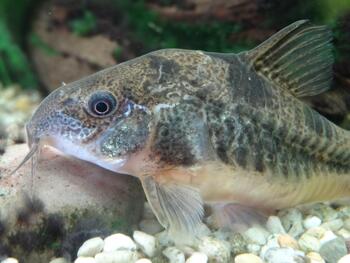
FAQs About Corydoras Eggs
Q1: How many eggs do Corydoras usually lay?
A female can lay anywhere from 20 to over 100 eggs per spawning, depending on the species and her health.
Q2: Do Corydoras eat their own eggs?
They don’t actively hunt down their eggs like some fish, but they may nibble on them or accidentally eat them while foraging.
Q3: Can I leave the eggs in the main tank?
You can, but survival rates will be much lower due to fungus, predation, and less controlled conditions. A separate hatching container is recommended.
Q4: How long do Corydoras eggs take to hatch?
Most Corydoras eggs hatch in about 72 hours, though temperature and species can affect the timeline slightly.
Q5: What do I feed Corydoras fry?
Start with microscopic foods like infusoria, then move on to baby brine shrimp and microworms as they grow.
Q6: Why are my Corydoras eggs turning white?
White eggs are unfertilized or dead. They should be removed quickly to prevent fungus from spreading.
Q7: Can methylene blue harm Corydoras fry?
When used properly and at the right dosage, methylene blue is safe and very effective at preventing fungal growth.
Final Thoughts
Raising Corydoras from eggs to fry can be one of the most rewarding experiences for an aquarist. These tiny, sticky eggs might not look like much at first, but with the right care, they hatch into lively, curious little catfish that bring endless energy to your tank.
The key is paying attention to the details: identifying fertilized eggs, preventing fungus, keeping the water clean, and providing proper food at every stage of growth. With patience and practice, you’ll soon have a thriving school of Corydoras bred and raised right in your own aquarium.

